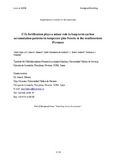Mostrar el registro sencillo del ítem
CO2 fertilization plays a minor role in long-term carbon accumulation patterns in temperate pine forests in the southwestern Pyrenees
| dc.creator | Lo, Yueh-Hsin | es_ES |
| dc.creator | Blanco Vaca, Juan Antonio | es_ES |
| dc.creator | González de Andrés, Ester | es_ES |
| dc.creator | Imbert Rodríguez, Bosco | es_ES |
| dc.creator | Castillo Martínez, Federico | es_ES |
| dc.date.accessioned | 2019-07-05T07:24:14Z | |
| dc.date.available | 2021-07-04T23:00:11Z | |
| dc.date.issued | 2019 | |
| dc.identifier.issn | 0304-3800 | |
| dc.identifier.uri | https://hdl.handle.net/2454/33521 | |
| dc.description.abstract | Isolating the long-term fertilization effect of CO 2 from other climate- and site-related effects on tree growth has been proven a challenging task. To isolate long-term effects of [CO2] on water use efficiency at ecosystem level, we used the FORECAST Climate forest model, calibrated for Scots pine (Pinus sylvestris L.) forests in the southwestern Pyrenees, growing at a Mediterranean montane site and at a continental subalpine site. Future climate scenarios (RCP 4.5 and RCP 8.5) were generated using a battery of six climate models to estimate daily values of temperature and precipitation in a 90-year series. A factorial experiment was designed to disentangle the importance on C pools of three growing limiting factors (nitrogen limitation, climate (temperature + precipitation) limitation and atmospheric CO 2 concentration). The relative importance of each factor was quantified by comparing the scenario with the limitation of each individual factor turned on with the non-limitation scenario. Positive CO 2 fertilization due to improvement in water use efficiency was detected by the model, but its quantitative impact improving tree growth was minimum: its average increase in ecosystem C pools ranged from 0.3 to 0.9%. At the site with cooler climate conditions (continental), the main limitation for tree growth was climate. Such limitation will be reduced under climate change and the ecosystem will store more carbon. At the site with milder climate conditions (Mediterranean), N availability was the main limiting factor albeit modulated by water availability. Such limitation could be reduced under climate change as N cycling could accelerate (higher litterfall production and decomposition rates) but also increase if droughts become more frequent and severe. In addition, the magnitude of the uncertainty related to climate model selection was much more important than CO 2 fertilization, indicating that atmospheric processes are more important than tree physiological processes when defining how much carbon could be gained (or lost) in forests under climate change. In conclusion, due to the small changes in forest C pools caused by variation of atmospheric CO 2 concentrations compared to changes caused by other growth limiting factors (nutrients, climate), reducing uncertainty related to climate projections seems a more efficient way to reduce uncertainty in tree growth projections than increasing forest model complexity. | en |
| dc.description.sponsorship | Funding for this research has been provided by the Spanish Ministry of Economy and Competitiveness (projects AGL2012‐33465, AGL2016-76463-P), a Ramón y Cajal contract (ref.RYC‐2011‐08082) and Marie Curie Actions (ref CIG‐2012‐326718‐ECOPYREN3,H2020-MSCA-IF-2014-DENDRONUTRIENT). | en |
| dc.format.extent | 44 p. | |
| dc.format.mimetype | application/pdf | en |
| dc.language.iso | eng | en |
| dc.publisher | Elsevier | en |
| dc.relation.ispartof | Ecological Modelling 407 (2019) 108737 | en |
| dc.rights | © 2019 Elsevier B.V. The manuscript version is made available under the CC BY-NC-ND 4.0 license. | en |
| dc.rights.uri | http://creativecommons.org/licenses/by-nc-nd/4.0/ | |
| dc.subject | Ecosystem-level model | en |
| dc.subject | FORECAST Climate | en |
| dc.subject | Ecosystem carbon | en |
| dc.subject | CO2 fertilization effect | en |
| dc.subject | Climate change | en |
| dc.title | CO2 fertilization plays a minor role in long-term carbon accumulation patterns in temperate pine forests in the southwestern Pyrenees | en |
| dc.type | Artículo / Artikulua | es |
| dc.type | info:eu-repo/semantics/article | en |
| dc.contributor.department | Institute for Multidisciplinary Research in Applied Biology - IMAB | es_ES |
| dc.rights.accessRights | Acceso abierto / Sarbide irekia | es |
| dc.rights.accessRights | info:eu-repo/semantics/openAccess | en |
| dc.embargo.terms | 2021-07-04 | |
| dc.identifier.doi | 10.1016/j.ecolmodel.2019.108737 | |
| dc.relation.projectID | info:eu-repo/grantAgreement/MINECO//AGL2012-33465/ES/ | en |
| dc.relation.projectID | info:eu-repo/grantAgreement/ES/1PE/AGL2016-76463-P | en |
| dc.relation.publisherversion | https://doi.org/10.1016/j.ecolmodel.2019.108737 | |
| dc.type.version | Versión aceptada / Onetsi den bertsioa | es |
| dc.type.version | info:eu-repo/semantics/acceptedVersion | en |




